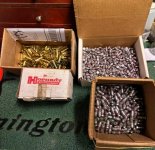Reloading for many years...
I began reloading in 1975, or there about, thanks to the generosity of an ex-cop friend, who had survived many gunfights during the 70's in Hartford, Ct. Hew was an Elmer Keith believer and used many of a load that resembled the Skeeter. He shot .38/.357, and .44 both special and magnum. Through his teaching, and my avid curiosity I loaded thousands of loads and became a locally noted revolver shooter. I reloaded almost ALL the ammo I shot for practice, duty, competition, and to satisfy my curiosity about loads NOT provided by factories.
I know I saved money too, which was of its own end.
Today at 70 years old, I am having to start up again as all my reloads I had stockpiled are now depleted. Costs in the 70-85 era were very reasonable, and I could save 4-5 dollars, per 50 rounds, over factory when shooting .38/.357. Wehn I began shooting .44 the cost saving was slightly higher due to the "Dirty Harry" demands for Magnums. I could buy .44 specials for about as cheap as .38 specials. Times were good.
NOW, cost of factory .44's of special or magnum as OUTYRAGEOUS! I blame "supply and demand' and the ammo manufacturers for allowing that. It translates to GREED, in my way of thinking. So I will reload again.
As stated earlier, I also am a thinker and curious about 'WHAT IF...". Recently I have been over-thinking/researching about using two 150Grain WC, in a .44 magnum case at about 800 fps max. I have just begun to experiment and the cost to reload them are about half to 2/3 of factory ammo, without the double tap capability per trigger pull. A S&W loaded with them would provide likely GREAT results if something must be shot to protect me or mine. I cannot give a $$ savings amount, but I KNOW it will be encouraging.
I personally know of the results of .38/357 HBWC, swagged to a tapered hollow point, on two human targets. I had loaded these to about 1000 fps,give or take, depending on barrel length. Both were one shot stops, and both parties did not survive. I wish I could find some soft cast HBWC in say 180 grain for the .44. Once again, reloading would be the best way to come up with a fight stopper, as the .44 caliber by itself is a pretty good bet with good reloads, whether Specials or Magnums, AND the cost would be GOOD, and factory will never make such a perfect round.
So call me a re-loader, or a hand-loader, it matters not to me, just pass me my rounds when I need them...and we are good.

